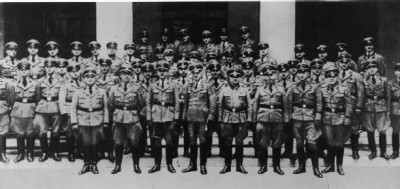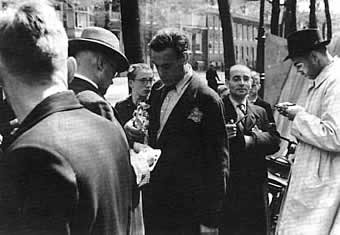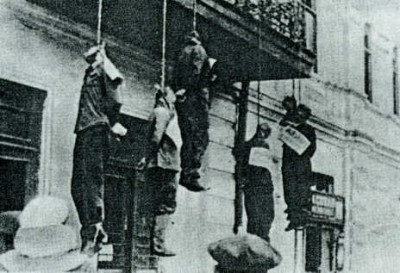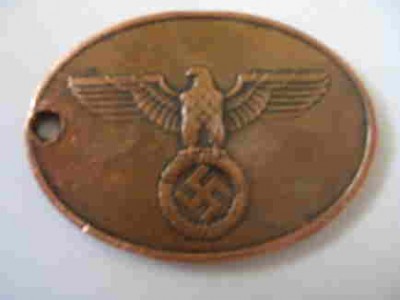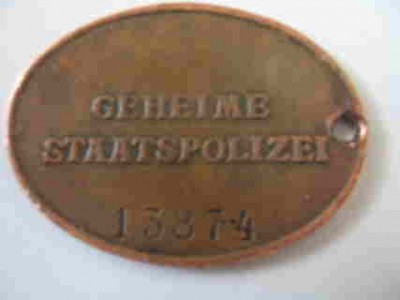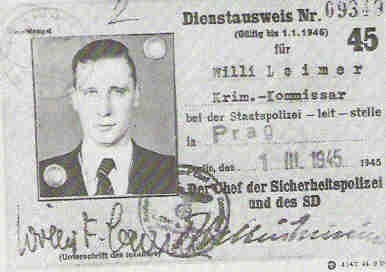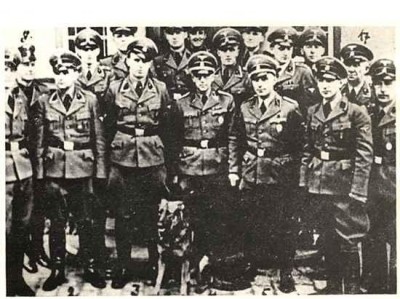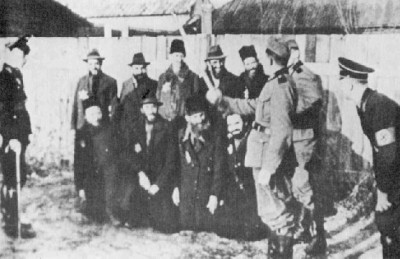Tajná státní policie
This post has not been translated to English yet. Please use the TRANSLATE button above to see machine translation of this post.
fotka by měla být z února 1943 z Charkova
This post has not been translated to English yet. Please use the TRANSLATE button above to see machine translation of this post.
Police employee SS-Mann, SS-Sturmann, SS-Rottenführer
Assistant developer SS subcontractor
Krim.Assistent SS-Scharführer, SS-Oberscharführer
Krim.Oberasistent SS-Hauptscharführer
Krim.Sekretär SS-Sturmscharführer
Krim.Obersekretär SS-Untersturmführer
Krim.Inspektor SS-Obersturmführer
Crimea. Commissioner of the SS main leader
Krim.Rat, Krim.Direktor SS-Sturmbannführer
Krim.Oberregierungsrat SS-Obersturmbannführer
Krim.Reg.Direktor SS-Standartenführer
SS SS Oberürührer
Ministerial Director of the SS Brigade Leader
Ministerial Conductor of the SS Group
Under-Secretary General of the SS Obergruppen
State Secretary SS-Oberstgruppenführer
This post has not been translated to English yet. Please use the TRANSLATE button above to see machine translation of this post.
Citace - bitaxe :
Mimochodem, gestapo vzniklo na popud Göringa ale on sám mu nikdy přímo nešéfoval, vzniklo z politického referátu pruské policie, tento referát byl původně silně obsazen sociálními demokraty, po 30. ledni 1933 a nástupu Göringa jako ministra vnitra, se na čelná místa dostali zasloužilí členové NSDAP a často členové SS a SA. někdy v polovině roku pak byl celý úřad přejmenován na tajnou státní policii. Dalším krokem byla centralizace policejních sil (dříve měla každá země svou policii a vlastní vládu) a následně i zvýšení pravomoci gestapa nad rámec normální policie. v prvním období nebyly vztahy mezi policií (i gestapem) a SS nebo SA hlídající vznikající koncentrační tábory nijak dobré, a v některých případech dokonce SA zahájila výstražnou palbu na úředníky policie kteří si přišli pro vězně. To se ovšem brzy změnilo, obě složky začali spolupracovat, zvláště po tom co se druhým velitelem gestapa stal R. Heydrich, reálně se zdá že opravdovým tvůrcem toho co si představujeme pod pojmem gestapo - tedy represívní aparát - vytvořil právě on. Kromě boje proti nepřátelům nacistického pořádku byl dalším úkolem gestapa i zpravodajská činnost(z našeho pohledu kontrašpionáž) zde se doplňovala s RSHA.
1. Když se dostal Göring do čela Pruska, tak skutečně vytvořil gestapo (z oddělení Ia Pruské státní policie. Nadřízeným byl z titulu své politické funkce, reálným šéfem byl R. Diels (Göring se mu později odvděčí tím, že ho vyškrtne ze seznamu smrti pro noc dlouhých nožů). Göring tedy ovládal policii v Prusku. V Bavorsku Himmler a ten posléze ovládl policii v celé říši. S Göringem se dohodli. Měli společného nepřítele: Röhma a jeho SA. Göring s SA v Prusku soupeřil o moc a v Himmlerovi a Heydrichovi (a rovněž v Reichenauovi, potažmo v Reichswehru, který SA nenáviděl) našel spojence. Gestapo tedy předal SSmanům (x na svoji ochranu si zřídil ale Landespolizeigruppe) - 1934 prakticky, 1936 de iure. Ti tak ovládali celou kontrašpionáž vyjma abwehru, který bude připojen až po likvidaci Canarise.
2. Rudolf Diels si skutečně zpočátku, kdy gestapu šéfoval, chodil pro vězně do koncentráků, bunkrů a věznic SA, kde esamani drželi a mučili spousty lidí. To se SA samozřejmě nelíbilo. Jednak tím bylo zpochybňována jejich "práce", druhak v tom cítili omezení své moci (celkově se cítili omezeni na odměnách za zásluhy o Machtübernahme, přestože všude nalezli různí SA-Berateři, kteří svým diletantismem spíše škodili - což se zajídalo spoustě lidí).
3. Gestapo se nedoplňovalo s RSHA, ale bylo jednou z jeho složek
This post has not been translated to English yet. Please use the TRANSLATE button above to see machine translation of this post.
Jinak to že příslušníci gestapa chodili normálně oblečeni (ne tedy v kožeňáku i v létě je vidět pokud se podíváte na jejich fotky. Právě teď u nás běží v muzeu výstava k osvobození a krom jiných je tam i část věnovaná místní služebně (jedna ze dvou v kraji) kde jsou fotky z běžného života (posezení s kolegy a podobně) samozřejmě jsou to normální lidé na pohled nerozlišitelní. Uvedené hodnosti jsou policejní (tedy třeba kriminální komisařú a na rozdíl od filmů kde se zdá že jich všude bylo tisíce ta pobočka (druhá byla v Táboře) má asi patnáct lidí i s ženami ve funkci písařek. podle toho to vypadá že vlastních výkoných členů bylo kolem deseti (měli krom jiného fotografa a tlumočníka - ten byl aspoň podle jména možná čech) docela by mne zajímalo kolik mělo gestapo v celém protektoráto lidí (nemyslím udavače, ale opravdu lidi kteří byla úředníka této policie)
The office is divided in five main departments:
I.department - the organizational, administrative, personal
II.department - economic and administrative affairs
III.department - the group for specific tasks, such as the investigation of treason, espionage in industrial plants, or contacts of the civilian population with prisoners of war. (later dissolved and divided into other departments)
IV. departments - the executive, the unit to determine the operating 1: operating formation for the fight with odbojovým movement, the implementation of important surveys, intervention in cases of sabotage and burglary of a political nature
-the unit for special purposes 2: the archive of the offices (the seized printed materials, flyers etc)
Continuous service for the reception of arrested, receiving reports from konfidentů and důvěrníků
In. from the middle of r. 1944 was as the fifth department of the zařaze Kripo (criminal police)
Each department is further divided on the papers:
I And W - the ratio of military officials, employees služebny
I And 1 - personal affairs of officials (appointment, odvelení, fold)
I And 3 - the personal affairs of the officers of the border police
I And 4 - injuries in the service, business honors
I And 5 - passenger department of the SS, přorovnávání business functions hodnostem SS
I And 6 - social welfare (security of widows and orphans of the fallen members of the gestapo, the celebration of personal anniversary)
I B 1 - training in the nac.ideology, the preparation of candidates to study in the school for leaders of the SS
I B 2 - training in the shooting, the staff of physical exercise and sport
I D - disciplinary affairs of officials and staff, questionnaires and testimonials
II - accounting department
II AND 1 - emoluments and salaries of officials, aid and assistance
II AND 2 - staff salaries and employees ' benefits
II AND 3 - care of the sick, vouchers to doctors, hospitals and SS lazaretů
II AND 4 - travel, odlučné, přetěhovávací fees, business tickets
II AND 5 - management and stock confiscated property
II B - management of buildings
II B 1 - matters of official buildings (car, building). Office supplies
II B 2 - issuance of official uniforms
II B 3 - výpomocné ošacování, the payment of contributions ošacovacíh
II B (4) - housing department, the allocation of service apartments
II B 5 - management of the industrial canteens and casinos
II C - technical affairs
II C 1 - phones
II C 2 - telex
II C 3 - alužební vehicles and drivers
II C 4 - management of service weapons, rounds and workshops
IV 1 - opposition
IV 1 a - a left-wing movement
IV 1 and 1 - communism
IV, 1 and 2 - zákázaný listening to the radio zahr.
IV 1 and 3 - evaluation and the file of flyers
IV 1 and 4 - masrxismus (socdem)
IV b - right-wing movement
IV 1 b 1 - a right-wing opposition
IV 1 b 2 - a right-wing associations, unions, individuals
IV 1 b 3 - film, press and cultural affairs, the collection of leaflets shozených from aircraft and balloons
IV, 1 c - foreign workers, zahaleči, prisoners of war
IV 1 c 1 - escapes from the work in the empire, avoidance of work, prisoners of war and their support, ensuring the family members of emigrants (to 1944), economic offences
IV 1 c 2 - Russian emigrants and dlěníci from the east, cizonárodní minorities and their organisations, checking, internování and monitoring of foreigners
IV 2 - sabotage
IV 2 and - sabotage, the arms industry and weapons
IV 2 and 1 - sabotage, guarding the arms industry, úmylsné sebezraňování, violations of labour deployment and staff morale, arson in the arms industry, atantáty
IV 2 and 2 - possession of weapons, firearms, passports, hunting tickets and permit the equipment, the hub and the třaskaviny, unauthorized possession of
IV 2 b - parachutists and partizáni, radio protihry
IV 2 b 1 - sabotage on the railways, komunikacíh, postal and telegrafním connection, power stations, water works to dams, offences against the work, the morality of political killings (assassinations)
IV 2 (b 2 - british paratroopers, Russian paratroopers and partisans, the organization of the collaborators (the so-called volavčí network), preparation of search events, radio protihry
IV 2 b 3 - decryption unit (Funkabwehr), protection against zahr. vasílání, tracking reports vysíláných zahr. radio
IV 2 b 4 - identification of the persons, of the photographic department, fingerprints
IV - 3 Defence news
IV 3 and - defense against espionage, zběhové, cases of treason, special checking, the affairs of the airports, the evaluation of the seized files spy character,
IV 3 b - economic affairs, the provision of industry, defense nominee, racing guard (Werkschutz), dohladací industrial commission, the loss of secret material, the protection of patents
IV 3 c - border issues, passports, laissez-passer, checking visas (up to 11/1944 then IV (G)
IV 3 d - guarding válečně important to the economy (in the 11/1944 after IV 3 (c)
IV 3 e - the connection to the frontline zpravodajcům, defense against nepčátelským reports.services
IV 4 - světonázorový opponent
IV 4 and - the church, the sect of freemasonry, terstné acts of spiritual, spiritualism, the unloading of the cards, soothsayers and fortune-teller
IV 4 b - the jews and of mixed ethnicity, emigrants
IV 5 - special cases
IV 5 and - the protection of senior officials, impersonation of an official authority (provocation), the interception tel.calls, special tasks (such as anonymous letters)
The permanent service (for managing the offices exercised this activity, the permanent group of officials)
IV 5 b - matters of the NSDAP and their components, printing
IV 6 - filing cabinets and a registry, the protective link
IV 6 and 1 - the main file of the arrested, a search file, the writings of the martial court, the affairs of the links, transports prisoners
IV 6 b - protective binding, pracovněvýchovné camps (from 1944)
IV N - msgs service and registration of konfindentů
IV F - research - research and the causes of the political and other events
IV G - border issues (from 11/1944 IV 3 (c)
IV M - connecting paper to the Wehrmacht and the Waffen SS, the organization of the defense management offices, outdoor služeben, the organization of the emergency evaluation.services
IV M 1 - protective service reports.contact, the protection of private mail, telex, optical and acoustic connections, postal pigeons..
-Personen (Vertrauenspersonen) - důvěrníci, certificate konfidenti serving regular reporting for the monthly salary.
W-Personen (Weber) - verbíři, their task was the expansion of the network konfidentů
G-Personen (Gewährspersonen) - a reliable person, occasionally assigned to certain areas and walks of life with the task of finding specific information.
And-Personen (Auskunftspersonen) - informants, casual informants (sometimes referred to also as I-Personen, informants). Some cooperated with the GESTAPO consciously, the information from the one obtained by the GESTAPO usually inform In-Personen, or G-Personen..
This post has not been translated to English yet. Please use the TRANSLATE button above to see machine translation of this post.
Rudolf Diels 1933 - 1934
Heinrich Himmler 1933 - 1936
Reinhard Heydrich 1936 - 1939
Heinrich Müller 1939 - 1945
| Business rank | Corresponding to the rank of SS | Annual salary (in RM) |
| High officials of the executive service: | | |
| criminal assistant | SS-Oberscharführer | 2160-2340 |
| chief criminal assistant | SS-Hauptscharführer | 2000-3000 |
| criminal secretary | SS-Untersturmführer | 2350-3500 |
| the high criminal secretary | SS-Untersturmführer | 2300-4200 |
| criminal inspector | SS-Obersturmführer | 2800-5000 |
| Leading officials of the executive service: | | |
| criminal commissioner | SS-Obersturmführer | 3900-5300 |
| criminal council | SS-Men | 4800-7000 |
| criminal director | SS-Waffen | 4800-7800 |
| government and of the crime council | SS-Waffen | 4800-8400 |
| the top of the government and of the crime council | SS-Obersturmbannführer | 7000-9700 |
| government and director of the criminal | SS-Standartenführer | 6200-10600 |
| the reich criminal police director | SS-Standartenführer | 6200-10600 |
| the Lower officials of the police administrative services: | | |
| official helper | SS-Unterscharführer | 1700-2400 |
| caretaker | SS-Scharführer | 1700-2400 |
| the high prison sergeant | SS-Oberscharführer | 1800-2700 |
| the main prison sergeant | SS-Hauptscharführer | 1800-2700 |
| High officials of police administrative services: | | |
| police assistant | SS-Oberscharführer | 2100-2800 |
| police general | SS-Untersturmführer | 2350-3500 |
| the chief of police secretary | SS-Untersturmführer | 2300-4200 |
| Leading officials of the police administration: | | |
| police inspector | SS-Obersturmführer | 2800-5000 |
| the senior police inspector | SS-Men | 2800-5300 |
| SS-Men | 3000-5800 | |
| police board | SS-Waffen | 4800-7000 |
Source:
BREWER, Richard: the Criminal role of the gestapo: the nazi security police in the Czech lands, 1938-1945, Our troops, Prague 1986..
Diskuse
This post has not been translated to English yet. Please use the TRANSLATE button above to see machine translation of this post.
2) Nemáš ještě nějaký jiný fotky, třeba z nějakejch jinejch měst?
This post has not been translated to English yet. Please use the TRANSLATE button above to see machine translation of this post.
Wolf..." uděla tohle a tohle. To s těma pláštěma: Jelikož to měla být tajná policie a měla mimo jiné získávat informace o "nepřátelích státu", tak nemohla mezi lidi v uniformě, pač by si lidi dávali pozor na to co říkají, tak asi jednoduše nosila civil. Že to byly ty černý a hnědý pláště, tak to bylo dobou- téměř v každém filmu pro pamětníky tak chodí lidi oblečení... Po nějakých fotkách se podívám...
This post has not been translated to English yet. Please use the TRANSLATE button above to see machine translation of this post.
This post has not been translated to English yet. Please use the TRANSLATE button above to see machine translation of this post.
s tou fotkou máš pravdu, je to přesně ten na koho ukazuje ta šipka, ti dva důstojníci v popředí ani nejsou od SS, v popisu se říká jen to, že ten Klaus Barbie byl taky důstojníkem SS, ne že každej gestapák byl od SS (jestli myslíš tohle)
This post has not been translated to English yet. Please use the TRANSLATE button above to see machine translation of this post.
Citace - Melkor :
Já jsem si myslel, že Gestapáci vždycky nosili takový ty hnědý pláště a propo mám na tebe tři otázky: 1) Mělo Gestapo nějaký hodnosti?
Ty hnědý pláště jsou spíše filmové klišé, aby divák hned poznal "záporňáka". Příslušníci GESTAPA nosili většinou běžné civilní oblečení, aby splynuli s davem. On by asi "tajnej", kterýho pozná sedmiletý dítě na 100 metrů nebyl moc platnej.
Co se týče uniforem SS, je to trochu složitější. Z nařízení H.Himmlera měl každý příslušník GESTAPA právo nosit uniformu SS s hodnostním označením odpovídajícím jeho služebnímu zařazení (viz.přehled níže), a to i v případě, že příslušníkem SS nebyl. Například v roce 1939 mělo GESTAPO necelých 20.000 úředníků a k SS příslušely pouhé tři tisícovky. Nicméně pokud chtěl úředník GESTAPA dostatečně rychle postupovat po služebním žebříčku poskytovalo mu členství v SS velmi podstatnou výhodu, ve vyšších funkcích se totiž v naprosté většině vyskytovali pouze členové SS. Ne každý příslušník GESTAPA, který se přihlásil k SS byl přijat, mnozí pro svůj vysoký věk, další pro své hříchy před nástupem nacistů k moci a někteří nemohli dostatečně prokázat svůj rasový původ.
Což nic neměnilo na tom, že jako příslušníci GESTAPA měli právo nosit uniformu SS.
Join us
We believe that there are people with different interests and experiences who could contribute their knowledge and ideas. If you love military history and have experience in historical research, writing articles, editing text, moderating, creating images, graphics or videos, or simply have a desire to contribute to our unique system, you can join us and help us create content that will be interesting and beneficial to other readers.
Find out more